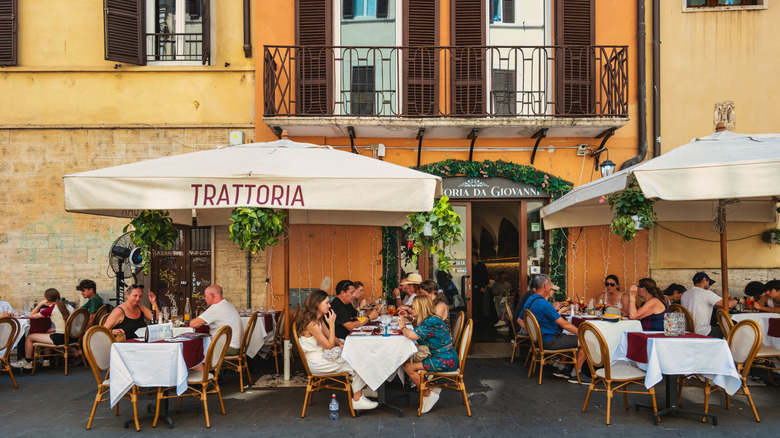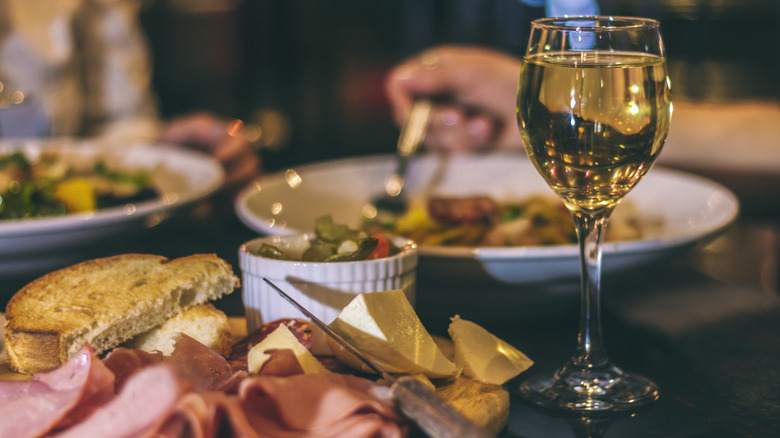Rick Steves Breaks Down The Difference Between Italy's Diverse Eateries
Italy is known for its historical sites, art museums, and beautiful scenery. However, one of the many reasons we visit (maybe the most important) is to experience the food. Italian cuisine has become ubiquitous in America, but there's nothing like the real thing. If your mouth is already watering, you may want to take some culinary advice from travel pro Rick Steves. Italy is a food-lover's dream, Steves says that Italy is the only country in Europe that keeps his palate interested outside of France, comparing Italian feelings about food to a religion. Steves even has a great breakdown of the differences between restaurants in Italy, and it can really help you find exactly what your tummy (and wallet) is looking for.
You may be confused by the difference between a ristorante, a trattoria, an osteria, and an enoteca, and Steves has all the info. A ristorante, he explains on his website, Rick Steves' Europe, is "more formal and upscale," so if you're looking for a fancy night out, that's where to go. A trattoria, on the other hand, "is usually a casual family-owned place serving home-cooked meals." This is a great spot to check out if you're looking for something less formal and more hearty. The definition of an osteria has shifted a bit, and he tells us, "While osteria used to mean a humble, rustic, good-value eatery, now it is likely to be trendy and pricey (but still good quality)." However, he says that if you're looking for something less expensive and still delicious, go for an enoteca. He explains, "These wine bars serve good, reasonably priced wine by the glass and pride themselves on simple menus featuring quality local and seasonal ingredients, well-cooked and economical."
What to look for when deciding where to eat in Italy, as per Rick Steves
Steves points out some things to look for, no matter which style of restaurant you're considering. One of those is a short, handwritten menu, which reflects the fact that the ingredients they're using change according to availability. It's one of the telltale signs that he says means you've found an authentic restaurant that you're going to enjoy. In fact, if you speak Italian, or you're at a place where the chef speaks English, he says your conversation with them if they visit the dining room is likely to be all about the ingredients. Look for things that are in season, and those seasons can be short. Steves mentions a stew called vignarola as an example, made with peas, lava beans, and artichokes, that is only made for a few weeks in the spring when everything is at its peak.
In addition, Steves has certain things he looks for in any dining spot, which is "personality-driven restaurants, run by people enthusiastic about sharing their love of good cooking, and characteristic mom-and-pop places serving family recipes," meaning you may very well want to chat with that chef. In terms of where to search for one, he says to look for lots of locals in a spot he calls "low rent." It's not an insult. In fact, one of the top travel tips we've learned from Steves is to avoid restaurants right by tourist sites. It's also best to avoid places that have someone outside calling people in, as well as menus in several different languages, as they're likely to cater to tourists. (You can use the Google Translate app's camera function to hover over a menu for an instant translation at places where there's no English.)
Steves' tips for ordering at a restaurant in Italy and a few other types to try
Steves has a few suggestions for ordering in an Italian restaurant as well. He explains that he tends to order antipasti, which are starter courses, and primi piatti, which are first courses, rather than getting the secondi, which is the second course that is often more expensive. In addition, he says that he often tells the server, "Mi faccia felice," which means "make me happy," with a price limit to see what offerings the chef thinks are best.
However, if you're looking for something fast and inexpensive for lunch as you're out exploring, Steves suggests another option for you. He says you can look at what is essentially a deli. He says to look for, "either a rosticceria, specializing in roasted meats and antipasti, or a tavola calda (hot table) bar — essentially a cafeteria featuring a buffet of meat and vegetables. Another budget option is to drop by an alimentari (neighborhood grocery) or salumeria (delicatessen) to pick up some cold cuts, cheeses, and other supplies for a picnic." In fact, a visit to a grocery store can give you a real sense of what daily life is like. Finally, Steves says to leave yourself a lot of time for your dinner out in Italy, as it's common for meals to last three hours. In fact, unlike America, they may not be in any rush to turn over your table. You may even have to ask for the check more than once. It's a lovely way to dine.


